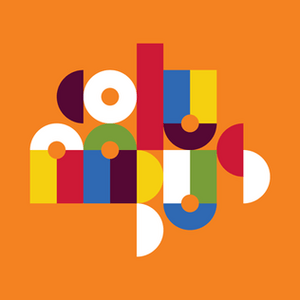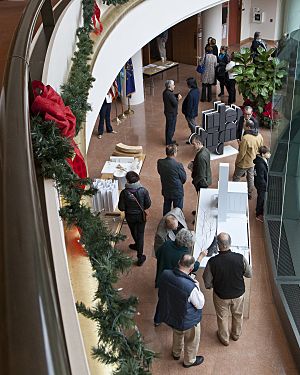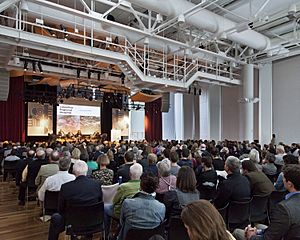Exhibit Columbus facts for kids
Quick facts for kids Exhibit Columbus |
|
|---|---|

Exhibit Columbus
|
|
| Genre | Festival, Biennale |
| Begins | 2016 |
| Frequency | Annually |
| Location(s) | Columbus, Indiana |
| Years active | 3 |
| Inaugurated | 2016 |
| Founder | Landmark Columbus |
| Website | http://www.exhibitcolumbus.org |
Exhibit Columbus is a special event in Columbus, Indiana. It's all about exploring amazing architecture, art, and design. This event helps people discover the city's cool design history. It also brings new ideas and art installations to life for everyone to see for free. A big part of Exhibit Columbus is the famous J. Irwin and Xenia S. Miller Prize.
This project has won awards and is praised for making Columbus, Indiana, famous again for its design. It started with a big meeting (called a symposium) in 2016. The first art show happened in 2017. The second show, called "Good Design and the Community," ran from August to December 2019. Exhibit Columbus has several main parts. These include the Miller Prize, projects by high school and university teams, and civic projects.
Contents
The Miller Prize: Honoring Design Heroes
The Miller Prize is a very important award at Exhibit Columbus. It honors J. Irwin Miller and his wife Xenia S. Miller. They were big supporters of architecture, design, and art. Their family helped make Columbus, Indiana, a special place for design.
This prize is the main event of both the Exhibit Columbus meetings and art shows. Winners are top international designers. They are chosen for believing that good design can make people's lives better. They also show how design can improve cities.
The Miller Prize brings unique designers to Columbus. They explore the city's famous design traditions. Each winning team gets to work on a special downtown spot. They create new art or buildings that help people see these places in a new way. This also connects people more to their community.
In 2016, ten designers competed for the prize. Five teams were chosen to build their designs. These designs explored the future of building and art. In 2018, five new studios were picked as Miller Prize winners. They were chosen for using art and architecture to improve lives. These new installations focused a lot on landscape architecture.
2019 Exhibition: Good Design in the Community
The 2019 exhibition opened on August 24 and ran until December 1, 2019. It featured 18 unique art and design projects. Architects, designers, and artists created these outdoor installations. They used Columbus's history and buildings as their inspiration. The projects also showed how a strong community helps create a lively city.
Exhibit Columbus looked back to a 1986 show for ideas. That show was called "Good Design and the Community: Columbus, Indiana." It was created when J. Irwin Miller was honored for his work. Mr. Miller wanted to show how the community helped build the city. He was proud of how people worked together.
The 2019 exhibition explored what "good design in the community" means today. It looked at how buildings and people's actions connect.
2019 Miller Prize Winners
The 2019 exhibition featured five J. Irwin and Xenia S. Miller Prize winners:
- Agency Landscape + Planning (Cambridge, MA)
-
- Site: AT&T Facility, designed by Paul Kennon
- Bryony Roberts Studio (New York, NY)
-
- Site: Columbus City Hall, designed by Edward Charles Bassett
- Frida Escobedo Studio (Mexico City, Mexico)
-
- Site: Cleo Rogers Memorial Library Plaza, designed by I.M. Pei and Partners
- MASS Design Group (Boston, MA; Kigali, Rwanda)
-
- Site: Central Middle School, designed by Ralph Johnson
- SO-IL (New York, NY)
-
- Site: Bartholomew County Courthouse Lawn, built by Isaac Hodgson
Washington Street Civic Projects
These projects brought new designs to Washington Street:
- Borderless Studio (Chicago)
- Extrapolation Factory (New York)
- LA Más (Los Angeles)
- People for Urban Progress (Indianapolis)
- PienZa Sostenible (Mexico City)
University Design Research Fellows
These fellowships show off new ideas from university professors. They highlight how design can make cities better.
- Viola Ago and Hans Tursack (Ohio State University and Massachusetts Institute of Technology)
- Sean Ahlquist (University of Michigan)
- Christopher Battaglia (Ball State University)
- Sean Lally and Matthew Wizinsky (University of Illinois at Chicago and University of Cincinnati)
- Daniel Luis Martinez and Etien Santiago (Indiana University)
- Marshall Prado (University of Tennessee)
High School Design Team
Columbus's design history began with investments in schools. Well-designed schools helped create a great education system. Inspired by J. Irwin Miller, Exhibit Columbus connects young people to this design heritage. The High School Design Team helps students learn about and contribute to this legacy.
Environmental Design and Wayfinding
Thirst, a design company, created a system to connect all the art installations. They used color-coded kiosks and an exhibition guide. A Family Activity Guide and an app called Hear/Here also helped visitors. This design system was like an 18th installation itself. It helped people understand the exhibition's purpose.
Publications, Mobile App, and Videos
Exhibit Columbus wanted everyone to enjoy the experience. The Family Activity Guide helped kids and families learn. It also let them interact with the art.
Hear/Here is an app that uses your location. It offers audio tours of the exhibition. You can also upload your own voice. The app includes old audio clips and interviews. It creates a new way to experience the city's design history.
2018 Symposium: Looking to the Future
The 2018 symposium took place from September 26 to September 29. It was about "Design, Community, and Progressive Preservation." This theme looked at new ways to protect old buildings and designs. It focused on innovation and creativity.
Over 1200 people attended the symposium. They visited many historic buildings in Columbus. The event ended with talks from the 2019 Miller Prize winners.
2017 Exhibition: First Public Show
The first Exhibit Columbus exhibition opened on August 26, 2017. It featured 18 art installations in downtown Columbus. Many groups helped fund the project. These included Ball State University and Cummins.
The 18 installations shown in 2017 included:
Miller Prize Installations
These five projects were art or architecture pieces. They were designed to interact with one of the Miller Prize Sites.
- Another Circle by Aranda\Lasch at Mill Race Park
- Anything can happen in the woods by Plan B at the Cummins Office Building
- The Exchange by Oyler Wu at the Irwin Conference Center
- Wiikiaami by studio:indigenous at First Christian Church
- Conversation Plinth by IKD at Cleo Rogers Memorial Library
2016 Miller Prize Finalists
Ten design teams were finalists for the 2016 Miller Prize.
- Benjamin Aranda and Chris Lasch of Aranda\Lasch
- Benjamin Ball and Gaston Nogues of Ball-Nogues Studio
- Herwig Baumgartner and Scott Uriu of Baumgartner + Uriu
- Rachel Hayes of Rachel B. Hayes Studio
- Eric Höweler and Meejin Yoon of Höweler+Yoon
- Yugon Kim and Tomomi Itakura of IKD
- Sharon Johnston and Mark Lee of Johnston Marklee and Jonathan Olivares
- Dwayne Oyler and Jenny Wu of Oyler Wu Collaborative
- Joyce Hsiang and Bimal Mendis of Plan B Architecture & Urbanism
- Chris Cornelius of studio:indigenous
2016-17 Miller Prize Sites
The Miller Prize installations were placed at these famous Columbus sites:
- First Christian Church (1942) by Saarinen and Saarinen
- Irwin Conference Center (1954) by Eero Saarinen and Associates
- Cleo Rogers Memorial Library (1969) by I.M. Pei and Partners
- Cummins Corporate Office Building (1984) by Kevin Roche John Dinkeloo Associates
- Mill Race Park (1992) by Michael Van Valkenburgh Associates
2016 Miller Prize Juried Presentations
On December 10, 2016, the 10 Miller Prize finalists showed their ideas to a jury. The presentations happened at Columbus City Hall. The jury included experts from museums and design.
Washington Street Installations
Five installations were chosen by leading design galleries. They were placed along Washington Street.
- Columbus Circles by Productora
- Pause by Pettersen & Hein
- Theoretical Foyer by Cody Hoyt
- Playhouse by Snarkitecture
- Window to Columbus by Formafantasma
University Installations
Five architecture schools created installations for the exhibition:
- Ball State University College of Architecture and Planning
- The Ohio State University Austin E. Knowlton School of Architecture
- University of Cincinnati School of Architecture and Interior Design
- University of Kentucky School of Architecture
- University of Michigan Taubman College of Architecture and Urban Planning
- Students from the Indiana University School of Art and Design also created a project.
High School Installation
- Between the Threads was created by high school students from Columbus schools.
Iterations of Installations
Some of the temporary art pieces from the exhibition have been shown again. They have appeared in other shows or new places.
- Alchemy was shown at the 2018 Venice Biennale of Architecture.
- Playhouse was part of a show for Snarkitecture at the National Building Museum in 2018.
- Theoretical Foyer by Cody Hoyt was given to the City of Columbus.
2016 Symposium: Foundations and Futures
The 2016 symposium was held from September 29 to October 1. It was called "Foundations and Futures." A sold-out session featured famous architects and designers. These included Deborah Berke and Robert A. M. Stern.
The symposium was the first step to launch the 2017 exhibition. All ten of the 2016 Miller Prize Finalists spoke at panel discussions. This symposium was recognized as a "Best Of Editors Pick" by NUVO newspaper.
Project Development: How it Started
Planning for Exhibit Columbus began in late 2014. The project officially started on May 5, 2016. It is a program of the Heritage Fund. It gets money from local people, groups, and companies.
100 Variations
In 2014, a pilot project called "100 Variations" was developed. Designer Jonathan Nesci created 100 unique tables. These tables were placed in front of First Christian Church. The tables were made in Columbus, Indiana.
Graphic Identity
Thirst, a graphic design company, was hired in 2016. They created the Exhibit Columbus logo and look. The goal was to match the designs of Paul Rand and Alexander Girard in Columbus. This design was quickly recognized with an award. It was mainly created by Rick Valicenti, a famous designer.



